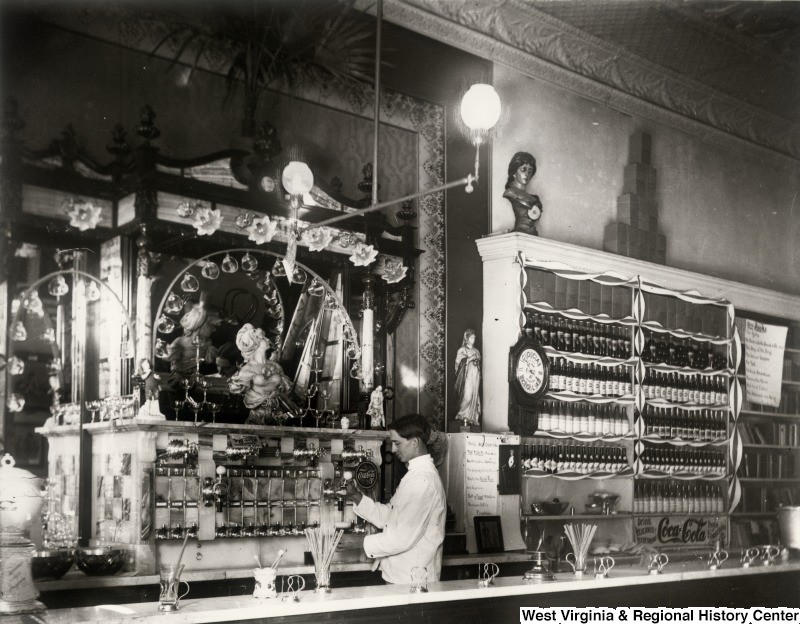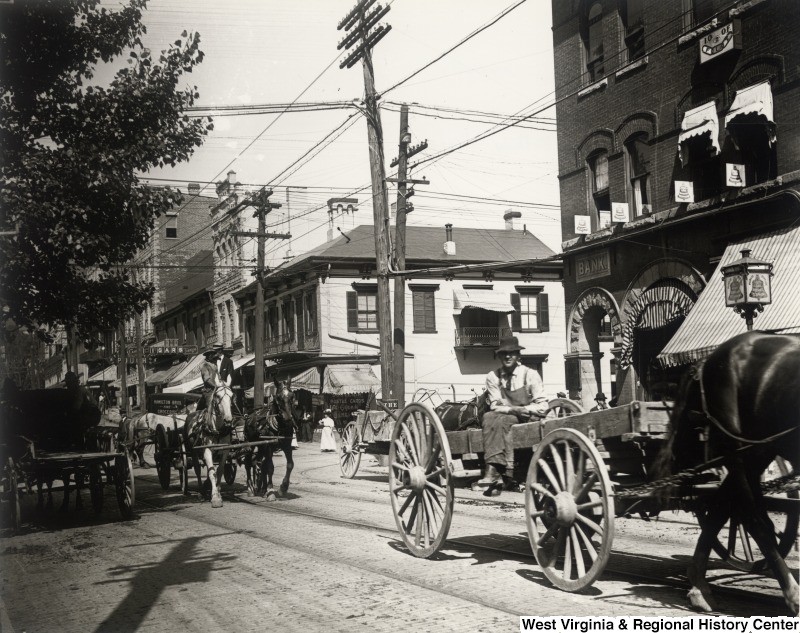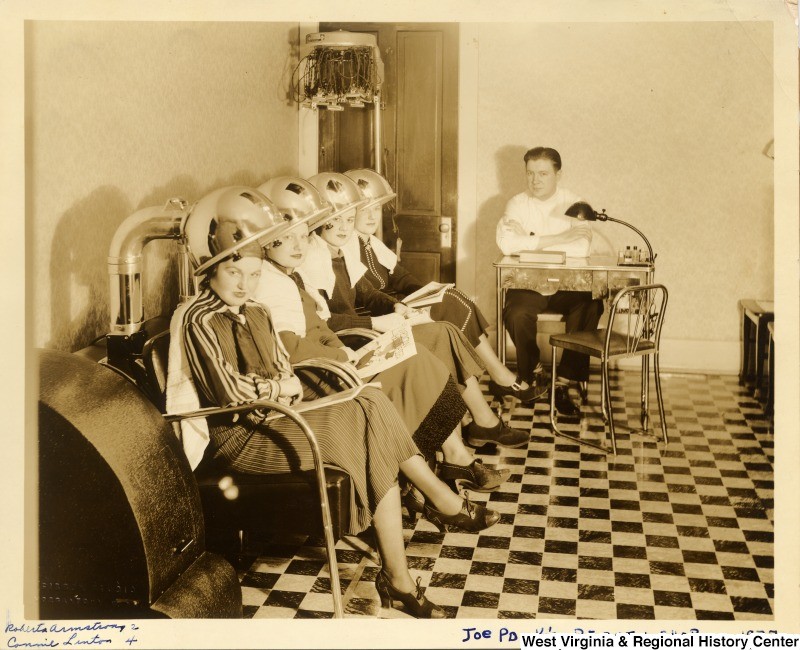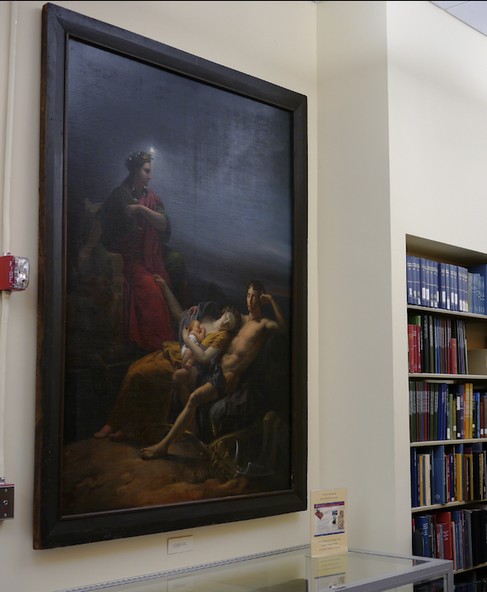West Virginia and Regional History Center, WVU Libraries
Introduction
Text-to-speech Audio
Located on the sixth floor of West Virginia University's Wise Library, the West Virginia and Regional History Center offers the largest collection of materials related to the history of West Virginia and central Appalachia. The center is open to the public and offers a library, manuscript collection, collects, preserves, and provides public access to materials that show the history and culture of West Virginia and the central Appalachian region.
Images
The library reading room is surrounded by published books about West Virginia history. This represents only a small portion of the library's collection.

Example of the Collections: Interior of Drug Store with Soda Fountain ca. 1900-1910 IDNO: 000018

Example of the Collections: Morgantown, W. Va. at the Intersection of High Street and Walnut ca. 1900 IDNO: 000019

Example of Collections: Interior of Joe Ponka's Beauty Shop ca. 1937 IDNO: 000029

Example of Collections: Log Tram Road at Mackeyville, Tucker County, W. Va. ca. 1893 IDNO: 000048

The WVRHC exhibits Justice Guarding the Sleeping World (1843) by David Hunter Strother, a West Virginian writer and artist

Backstory and Context
Text-to-speech Audio
The WVRHC is divided into multiple units: the regional history collection, the rare books collection, and other special collections. The Center is best known for its Archives and Manuscripts department. These collections include personal, family, and business papers, most of which have a direct connection to the history of West Virginia and central Appalachia. It also includes the University Archives. These materials include more than 4,000 collections that include records and material related to WVU's administration faculty, athletic teams, and student organizations.
The Center maintains a Rare Books Collection. Among the rare books of great significance in this collection are William Shakespeare's Four Folios and the Nuremberg Chronicle of 1493. The collection also includes historic first prints by leading American authors from Jane Austen to Charles Dickens. The collection also includes historic prints of many of the first books of history and literature that were printed in Virginia and the counties that presently make up the state of West Virginia.
The Center dates back to 1930, when the University Library accepted the responsibility of preserving the papers of Senator Waitman T. Willey, a founding father of West Virginia. The library's collection has grown from these humble beginnings, now including over 20,000 linear feet of personal papers, photos, pamphlets, business records, and more. The digital collection includes multiple terabytes of digital content, books, microfilm, audio recordings, and more.
The West Virginia and Regional History Center hosts changing exhibits and also permanent display cases of objects and works of art. One work of art on display in the reading room is Justice Guarding the Sleeping World by David Hunter Strother, a journalist, artist, soldier, and diplomat. Born in September 1816 in Martinsburg, Strother painted this piece in 1843, during a three year journey to Europe, in which he found himself in a frenzy of artistic activity, producing nine paintings in 12 months. These three years were crucial to the life of Strother, as he yearned for a better understanding of the European artist he hoped to imitate. The painting depicts a sleeping family: a man, a woman, and their baby as a woman sits watch over them. The image creates a sense of understanding that justice looms over this world as its fated guardian. Strother, also going under the pseudonym ‘Porte Crayon,’ would go on to serve in the Union Army during the Civil War, where he would fight in over thirty battles. Strother would spend the rest of his days in West Virginia, where he would die at the age of 71 in Charles Town.
The Center maintains a Rare Books Collection. Among the rare books of great significance in this collection are William Shakespeare's Four Folios and the Nuremberg Chronicle of 1493. The collection also includes historic first prints by leading American authors from Jane Austen to Charles Dickens. The collection also includes historic prints of many of the first books of history and literature that were printed in Virginia and the counties that presently make up the state of West Virginia.
The Center dates back to 1930, when the University Library accepted the responsibility of preserving the papers of Senator Waitman T. Willey, a founding father of West Virginia. The library's collection has grown from these humble beginnings, now including over 20,000 linear feet of personal papers, photos, pamphlets, business records, and more. The digital collection includes multiple terabytes of digital content, books, microfilm, audio recordings, and more.
The West Virginia and Regional History Center hosts changing exhibits and also permanent display cases of objects and works of art. One work of art on display in the reading room is Justice Guarding the Sleeping World by David Hunter Strother, a journalist, artist, soldier, and diplomat. Born in September 1816 in Martinsburg, Strother painted this piece in 1843, during a three year journey to Europe, in which he found himself in a frenzy of artistic activity, producing nine paintings in 12 months. These three years were crucial to the life of Strother, as he yearned for a better understanding of the European artist he hoped to imitate. The painting depicts a sleeping family: a man, a woman, and their baby as a woman sits watch over them. The image creates a sense of understanding that justice looms over this world as its fated guardian. Strother, also going under the pseudonym ‘Porte Crayon,’ would go on to serve in the Union Army during the Civil War, where he would fight in over thirty battles. Strother would spend the rest of his days in West Virginia, where he would die at the age of 71 in Charles Town.
Sources
West Virginia and Regional History Center. Accessed 1/25/2015 https://wvrhc.lib.wvu.edu/
